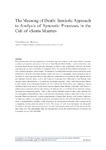Mostrar o rexistro simple do ítem
The meaning of death: semiotic approach to analysis of syncretic preceddes in the cult of "santa muerte
| dc.contributor.author | Grzegorz Michalik, Piotr | es_ES |
| dc.date.accessioned | 2014-10-02T12:31:34Z | |
| dc.date.available | 2014-10-02T12:31:34Z | |
| dc.date.issued | 2012 | es_ES |
| dc.identifier.citation | Culture of communication / Communication of culture, 2012: 605-612. ISBN: 978-84-9749-522-6 | es_ES |
| dc.identifier.isbn | 978-84-9749-522-6 | es_ES |
| dc.identifier.uri | http://hdl.handle.net/2183/13361 | |
| dc.description.abstract | [Abstract] The proposed paper discusses applicability of semiotic approach inspired by the work of Boris Uspienski to analysis of syncretic processes in the cult of Santa Muerte (Saint Death), a controversial folk saint. Although Santa Muerte enjoys growing popularity in Mexico and neighboring countries, the details concerning the cult have been hardly investigated. One of the reasons for Santa Muerte's popularity is the cult’s extensive presence in mass media. The absence of a central institution that would establish the canon of beliefs as well as the individual character of the cult, leaves its iconography and ritual practice open to influences of various spiritual currents. Santa Muerte is associated with a number of other popular, formal and informal, Mexican saints, such as the Virgin of Guadalupe, Jesus Malverde or San Pascual, often through a direct identification, or by assuming wife/helper functions. Urban curers having Santa Muerte as their patron saint intermingle elements of folk Catholicism, Spiritualism, and indigenous healing methods in their ritual practice. In the Afro-Christian Santeria, Santa Muerte is identified with Yemayá, a goddess-saint connected with sea and maternity. In addition, the cult of Santa Muerte has been strongly influenced by commercial esoteric. There is also a clearly traceable impact of heavy metal aesthetics on the iconography of Santa Muerte, that in turn intensifies the popular, erroneous association of the cult with Satanism. Patterns of syncretic overlap (contamination) of figures from diverse belief systems, elaborated by Uspienski, enable us to organize phenomena associated with the cult of Santa Muerte as well as to create a comprehensible, dynamic model structuring the heterogeneous elements which emerge on the iconographic, lexical, ritual and narrative levels. The concept of myth as an ontological text along with the theory of semantic dominant are proven to be useful and complementary tools for the analysis of lifestory interviews. The ethnographic data had been gathered during the author's fieldwork in Mexico and Guatemala between 2007 and 2008. | es_ES |
| dc.language.iso | eng | es_ES |
| dc.publisher | Universidade da Coruña | es_ES |
| dc.title | The meaning of death: semiotic approach to analysis of syncretic preceddes in the cult of "santa muerte | es_ES |
| dc.type | info:eu-repo/semantics/conferenceObject | es_ES |
| dc.rights.access | info:eu-repo/semantics/openAccess | es_ES |






